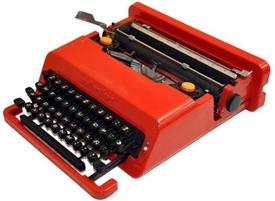 Maybe it began last spring when I learned about the "Writer In The Window" series at Market Block Books, Troy, N.Y. Amy Halloran would be "sitting in one of our windows with her typewriter composing poems, letters, stories for passersby," the bookstore's website explained, while inviting people to "bring your young children to see the ancient writing device she employs for her craft!"
Maybe it began last spring when I learned about the "Writer In The Window" series at Market Block Books, Troy, N.Y. Amy Halloran would be "sitting in one of our windows with her typewriter composing poems, letters, stories for passersby," the bookstore's website explained, while inviting people to "bring your young children to see the ancient writing device she employs for her craft!"
Ancient writing device. I liked that description. Since I've never been a romantic where typewriters are concerned, nostalgia just isn't an option. I was introduced to Apple's Mac Plus keyboard while working as a trade magazine editor in the late 1980s and never looked back. Prior to that, I'd spent a couple of decades pounding away at a succession of manual--and then electric--typewriters and was ready for my ears and finger calluses to heal.  In June at BookExpo, I saw a photo of Aleksandr Solzhenitsyn's manual typewriter during a presentation about the late Russian author's archives by his widow, Natalia. Solzhenitsyn is a writer who means a great deal to me. I snapped a photo of the screen, as if capturing an image of a mechanical ghost. As it was, in a way.
In June at BookExpo, I saw a photo of Aleksandr Solzhenitsyn's manual typewriter during a presentation about the late Russian author's archives by his widow, Natalia. Solzhenitsyn is a writer who means a great deal to me. I snapped a photo of the screen, as if capturing an image of a mechanical ghost. As it was, in a way.
These two incidents opened a typewriter vault during the summer, as I gradually became aware of keyboard specters, in an "I see dead typewriters" sense, everywhere I turned. They seemed to have risen from the shallow graves of antique shops and were "making news." Salon described the phenomenon as "a typewriter renaissance," noting "hipsters and newbies alike rediscover those beautiful machines that go clickety-clack."
Jesse Banuelos of Berkeley Typewriter told Salon that most of the typewriters he sold were manuals made between the early 1900s and the 1960s. The brands on display in his front window "read like a row of multicolored tombstones: Royal, Remington, Underwood, Smith-Corona, Olivetti, Corona, Adler, Oliver."  But typewriters remain in the past tense for me. In the recently published The Richard Burton Diaries, the actor writes of a "brand new Olivetti typewriter" he received as a gift in 1970 and describes the "fire-engine red" machine as "sparkling and very loose compared with the old Hermes Baby and it will take me a little time to bang away on it with the same abandon as I do on the old one which I shall keep anyway out of loyalty for many years of battered service."
But typewriters remain in the past tense for me. In the recently published The Richard Burton Diaries, the actor writes of a "brand new Olivetti typewriter" he received as a gift in 1970 and describes the "fire-engine red" machine as "sparkling and very loose compared with the old Hermes Baby and it will take me a little time to bang away on it with the same abandon as I do on the old one which I shall keep anyway out of loyalty for many years of battered service."
And yet, manual typewriters are flourishing in present tense as well, now that "they've found new fans among hipsters who are repurposing them for the digital age," Salon wrote. Banuelos noted that you have to be a bit of a romantic to want a typewriter, "and besides, they're cool." His customers "want a machine that has to be old, unique and nice. Why? Because of this. The click, click, click. They want that.... Let me tell you something. Young kids today, they want one of these machines."
More than a year ago, the New York Times wrote about the digital generation "gathering in bars and bookstores to flaunt a sort of post-digital style and gravitas, tapping out letters to send via snail mail and competing to see who can bang away the fastest."
Can you hear them? Clickety-clack. Clickety-clack. Clickety-clack. Click. Click. Click. Like bones rattling. Listen to the Boston Typewriter Orchestra's rendition of "Entropy Begins in the Office." Imagine Bartleby and Edgar Allan Poe in adjoining cubicles.
It isn't just the original clickety-clacks, of course. The magic spell of typewriters has been invoked with the iTypewriter, USB Typewriter, Chromatic Typewriter and an array of recycled Steampunk keyboards. If you're both nostalgic and computer keyboard-loyal, "you can make your laptop or desktop computer clang like a typewriter." There's even an app for that. I don't know what to say about the Latvian magazine that created @hungry_birds, a Twitter account featuring tweets by local wild birds pecking at the keys of an outdoor keyboard covered with unsalted fat.
Typewriters are cool. Suddenly, in this alternate universe, I've gone from not caring about manual typewriters at all to becoming too old and unhip for them. OMG! On the other hand, one aspect of the typing universe has altered slightly in my favor. As electronic keyboards shrink to tablet and smartphone dimensions, my self-taught typing technique is finally logical and even recommended. I'm a four-finger--yet blindingly fast on a good day or because of incessant deadline desperation--sort of typist. This style is perfectly suited to my iPad mini, but I can definitely feel a cold chill run up my spine as Mavis Beacon frowns with disapproval out there somewhere. Clickety-clack.--Robert Gray, contributing editor (column archives available at Fresh Eyes Now).

